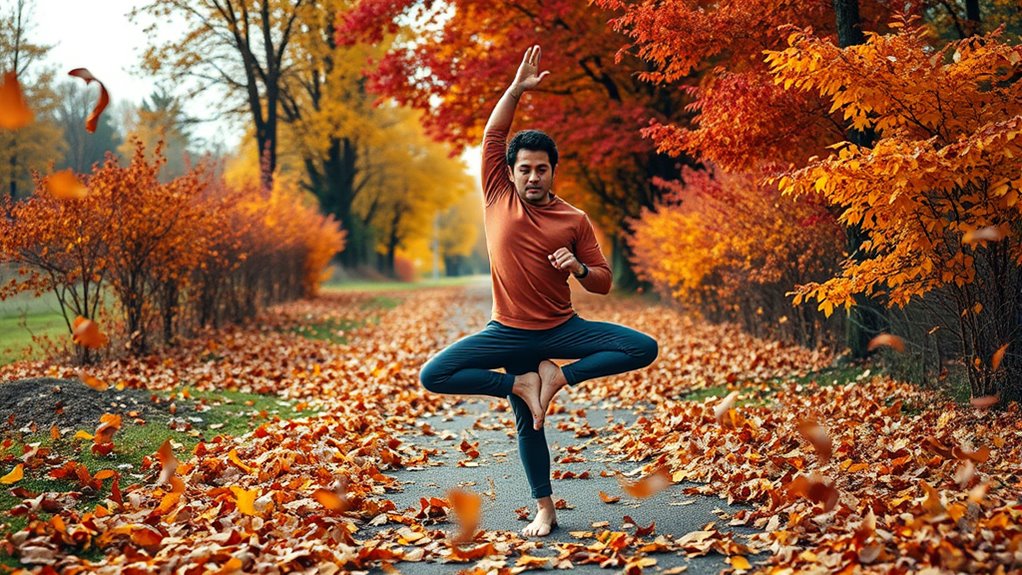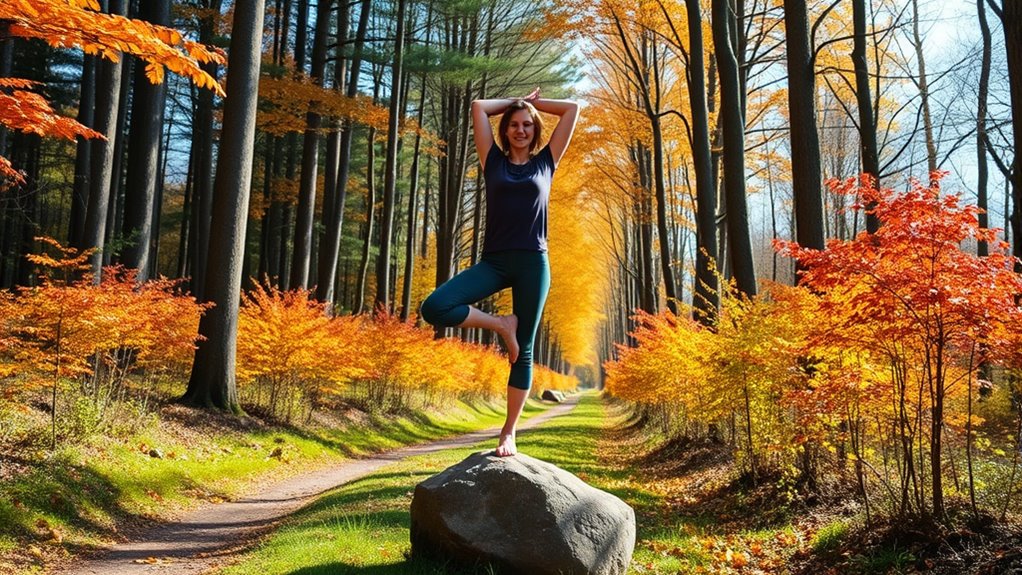Adapting your balance exercises for each season helps improve stability year-round. In fall, walk on leaf-littered surfaces and challenge yourself against gusty winds. In winter, focus on controlled steps on ice and snow, using traction aids. During spring, balance on uneven ground and mimic gardening tasks. Summer routines can include plank holds and single-leg stands outdoors. Incorporating safety tips and seasonal gear guarantees your exercises stay effective and safe—discover more ways to refine your seasonal balance routine below.
Key Takeaways
- Tailor balance routines to seasonal conditions, using outdoor surfaces in fall and spring, and indoor exercises in winter and rainy weather.
- Incorporate seasonal equipment modifications, like footwear and stability aids, to enhance safety and effectiveness across different environments.
- Practice season-specific exercises such as leaf-litter balancing in fall or snow-shoe stability drills in winter.
- Adjust your routine based on weather, opting for indoor yoga poses during rain or snow and outdoor activities in favorable conditions.
- Prioritize safety by regularly inspecting gear, choosing proper support, and being mindful of environmental hazards each season.

As the leaves fall and the wind picks up, it’s the perfect time to challenge your balance skills outdoors. Littered pathways create a natural balance beam, where leaf crunching underfoot tests your stability. Focus on steadying yourself with each step, feeling the uneven surface shift beneath you. Gusty winds add an extra challenge, forcing you to engage your core and adjust your posture to stay upright. Use the wind to your advantage—lean into it slightly to improve your stability. Pay attention to your surroundings and maintain awareness of shifting leaves and swirling gusts. This practice helps build proprioception and strengthens your stabilizing muscles, preparing you for more challenging balance exercises in the future. Incorporating balance exercises into your routine can enhance overall coordination and prevent falls. Embrace the outdoor elements as part of your training.
Winter Stability Practices for Icy Conditions

Have you ever wondered how to stay balanced on slippery, icy surfaces? Winter demands extra focus on ice traction and snow agility. To improve stability, try these practices:
- Focus on small, deliberate steps to maintain control and prevent slips.
- Use footwear with good grip or slip-on traction devices to boost ice traction.
- Practice quick, controlled shifts in weight to enhance snow agility and adapt to uneven surfaces.
These methods help you stay steady during icy conditions, reducing fall risk. Remember, engaging your core and looking ahead instead of down increases balance. Incorporate these exercises regularly, and you’ll build confidence navigating winter’s slick terrain with better ice traction and snow agility. Stay safe and keep your stability sharp through mindful, targeted practices.
Springtime Balance Routines for Blooming Days

Springtime offers the perfect opportunity to refresh your balance routines and enjoy the outdoors. Take advantage of blooming flower beds by doing flower bed exercises—step onto uneven surfaces, balance on one leg, and engage your core as you mimic gardening tasks. These activities improve stability and coordination while connecting you with nature. You can also incorporate bird watching balance drills: stand still on one foot, gently shift your weight, and focus on visual cues from the sky. These drills challenge your proprioception and help develop steadiness during everyday movements. As the days warm, make these routines a regular part of your outdoor activities. Not only will you boost your balance, but you’ll also deepen your appreciation for spring’s vibrant beauty. Incorporating balance exercises can further enhance your stability and overall wellness throughout the season.
Summer Stability Drills for Sunny Adventures

With longer, sunnier days inviting outdoor adventures, summer is the perfect time to incorporate stability drills into your routine. These exercises boost your core stability and improve posture alignment, helping you stay balanced on uneven terrain or during active outings. To get started:
Enjoy sunny days with stability drills to boost core strength and stay balanced outdoors.
- Plank Variations: Hold a forearm or straight-arm plank to engage your core and keep your spine aligned.
- Single-Leg Balance: Stand on one leg, focusing on tightening your core to maintain stability.
- Bicycle Crunches: Strengthen your core muscles, supporting better posture and injury prevention while outdoors.
Incorporating these drills helps you stay confident and steady during summer adventures, ensuring you enjoy every sunny moment with a strong, balanced body.
Incorporating Balance Exercises Into Your Seasonal Workout

Seamlessly integrating balance exercises into your seasonal workout can enhance your overall stability and prevent injuries throughout the year. To do this, start by incorporating yoga stretches that improve flexibility and focus on your breathing, which helps with concentration and balance. Add core strengthening moves like planks or leg lifts, which build the muscles essential for maintaining stability. You can perform these exercises during warm-ups or cool-downs, making them a natural part of your routine. Consistency is key—practice a few minutes daily to see progress. Adjust the difficulty level as you improve, challenging yourself with single-leg balances or dynamic movements. Incorporating essential exercises that target core and balance can further boost your stability and overall fitness. By weaving these exercises into your seasonal workouts, you’ll develop a more resilient, balanced body ready for any activity.
Safety Tips for Practicing Balance Throughout the Year

Practicing balance exercises year-round requires taking safety precautions to prevent falls and injuries. First, pay attention to footwear selection—wear supportive shoes with good grip to reduce slipping risks. Second, stay hydrated by following proper hydration strategies, especially during outdoor workouts, to keep your muscles and joints functioning at their best. Third, always practice in a safe environment, free of clutter or hazards, and consider using a sturdy chair or wall for support if needed. Be mindful of weather conditions, such as icy or wet surfaces, which can increase fall risk. Regularly check your footwear for wear and tear, and adjust your hydration habits based on activity level and weather. Additionally, understanding the contrast ratio of your surroundings can help you assess lighting conditions and prevent accidents. These simple precautions help ensure your balance exercises remain safe and effective throughout the year.
Adjusting Your Balance Routine for Changing Environments

As the seasons change, you’ll need to adjust your balance routine to suit different environments. Indoor and outdoor surfaces vary, and weather conditions can impact your stability and safety. Consider updating your equipment and techniques to stay balanced year-round. Incorporating dynamic contrasts into your exercises can further enhance your adaptability and responsiveness in varying conditions.
Indoor vs. Outdoor Surfaces
When shifting your balance exercises between indoor and outdoor surfaces, it’s important to recognize how different environments can affect your stability. Indoor stability often provides a smooth, predictable surface, making it easier to focus on form and control. Outdoor footing, however, can be uneven or slippery, challenging your balance more and engaging stabilizer muscles. To adapt:
- Use sturdy indoor surfaces like mats or hardwood floors for controlled practice.
- When outdoors, choose flat, dry areas with stable footing to reduce risk.
- Adjust your exercises based on surface texture—on outdoor terrain, focus on small, deliberate movements to maintain balance.
- Incorporating sound vibrations or calming music during your routine can help improve focus and relaxation, enhancing your overall stability.
Adapting to Weather Changes
Changing weather conditions can considerably impact your balance exercises, requiring you to adapt quickly to ensure safety and effectiveness. When outdoors, slippery surfaces or strong winds can challenge your stability. Adjust your routine by choosing stable environments or modifying poses, like replacing a challenging balance beam walk with ground exercises. During rain or snow, opt for indoor yoga poses such as Tree Pose or Warrior III to maintain balance focus. Use the table below to visualize adjustments:
| Weather Condition | Adaptation Ideas |
|---|---|
| Wind | Perform exercises indoors |
| Rain/Snow | Switch to yoga poses or indoor routines |
| Clear & Calm | Incorporate balance beam walks |
Seasonal Equipment Adjustments
Adapting your balance routine with seasonal equipment changes can enhance safety and effectiveness. As the seasons shift, consider footwear modifications to better suit the environment—thicker soles for winter or breathable shoes for summer. Proper footwear helps maintain grip and stability. Additionally, reassess your balance aid selection: lightweight poles for summer hikes or sturdier supports for icy conditions. Regularly inspecting your bicycle tires for wear and proper inflation can prevent slips during outdoor activities. Here are three tips to get started:
- Switch to shoes with better traction during wet or icy months.
- Use adjustable balance aids to match changing terrain.
- Incorporate insoles or orthotics for added support when needed.
Adjusting your equipment guarantees you’re comfortable and secure, reducing the risk of slips and falls as environments change. Stay prepared and adapt your gear seasonally for suitable balance training.
Frequently Asked Questions
How Often Should I Update My Balance Exercises Each Season?
You should update your balance exercises each season based on your progress and changing needs. Typically, aim for an exercise frequency of about 2 to 3 times per week. Seasonal adjustment is key; as weather and activity levels shift, modify your routines to stay challenged and safe. Regularly reassessing your balance allows you to personalize your workout intensity and prevent plateaus, ensuring continuous improvement.
Can Balance Exercises Help Prevent Seasonal Injuries?
Yes, balance exercises can help prevent seasonal injuries by improving your stability and fall prevention. When you strengthen your core and leg muscles, you become more confident on uneven or slippery surfaces common in different seasons. Regularly practicing these exercises helps you react quickly to unexpected slips or trips, effectively reducing injury risk. Incorporate balance routines into your seasonal fitness plan to stay safer and more resilient year-round.
Are There Specific Balance Routines for Different Age Groups?
You might think balance routines are one-size-fits-all, but they’re actually tailored for each age group. Age-specific routines make sure exercises are safe and effective, addressing developmental or age-related needs. For kids, focus on fun, dynamic activities; for seniors, emphasize stability and gentle movements. By choosing age-appropriate exercises, you optimize benefits and minimize risks, helping everyone maintain balance and prevent falls, no matter their stage of life.
How Do Weather Changes Affect Balance Training Effectiveness?
Weather changes can impact your balance training effectiveness by requiring weather adaptation. Cold, wet, or windy conditions may make outdoor exercises unsafe or uncomfortable, leading you to skip sessions. To maintain exercise consistency, you might need to switch to indoor routines or modify your outdoor activities. Adapting to weather guarantees you stay active and engaged, helping you improve your balance regardless of seasonal shifts.
What Equipment Is Best for Seasonal Balance Workouts?
Think of your equipment as your trusty tools on a journey. Balance mats provide a stable foundation, symbolizing grounding and focus, while resistance bands add flexibility and strength, representing resilience. These tools are perfect for seasonal balance workouts because they adapt to changing conditions and help you stay steady. With balance mats and resistance bands, you create a versatile, effective routine that keeps your stability sharp, no matter the weather.
Conclusion
Practicing balance year-round keeps you agile and reduces fall risks, which affect over 3 million older adults annually. By adapting your routines to seasonal changes, you can stay steady on different surfaces and conditions. Remember, incorporating just 10 minutes of balance exercises daily can improve stability and confidence. Stay mindful of your environment, and you’ll enjoy safer, more confident movement through every season’s challenges. Keep balancing, and stay safe all year long!









